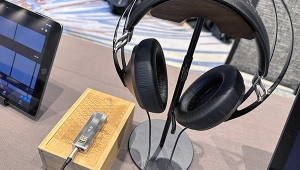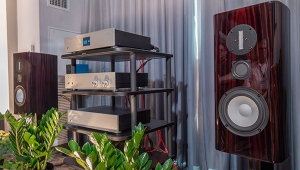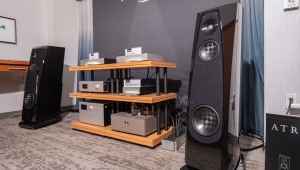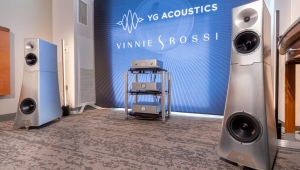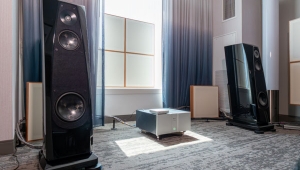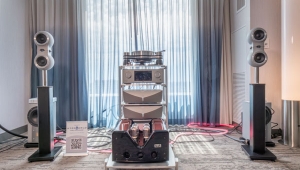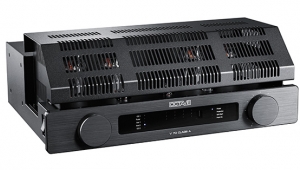| Columns Retired Columns & Blogs |
Audio Research Classic 60 power amplifier Measurements
Sidebar 3: Measurements
Footnote 1: I did not carry out any power or distortion measurements from the 16 ohm taps. Not having access to any loudspeakers that would be suitable (possessing a combination of high sensitivity and high impedance) for auditioning from these taps, I regard them as irrelevant in a real-world system.—John Atkinson
The Classic 60 measured as having a flat response across the audio band (fig.1), apart from a slight rolloff above 10kHz, reaching -0.32dB at 20kHz. This will be just audible as a very slightly soft top octave, but is otherwise inconsequential. Crosstalk was also inconsequential: fig.2 shows the leakage from Channel 1 into Channel 2 with the Channel 2 input shorted, below -120dB across the band, which is effectively buried in the amplifier's noise floor. Looking at the amplifier's response with an input signal consisting of a 200µs, positive-going, rectangular pulse revealed that the 60 is non-inverting when connected conventionally; ie, with the positive speaker connection taken from the 4, 8, or 16 ohm tap and the ground connected to "0."

Fig.1 Audio Research Classic 60, 8 ohm tap, frequency response at 1W into 8 ohms (0.5dB/vertical div.).

Fig.2 Audio Research Classic 60, crosstalk R-L, L input shorted (10dB/vertical div.)
The Classic 60's input impedance was 100k ohms, while its output impedance varied according to what transformer tap was being used. At 1kHz and a 2.83V RMS output level, from the 4 ohm taps I measured 0.3 ohms (Channel 1) and 0.34 ohms (Channel 2), from the 8 ohm taps 0.45 and 0.5 ohms (1 and 2, respectively), while Channel 2 measured 0.65 ohms at 1kHz from the 16 ohm tap. At the frequency extremes, the output impedance at 20Hz was identical to that at 1kHz, while at 20kHz it rose a little, reaching 0.9 ohms, 1 ohm, and 0.7 ohms for Channel 2's 16, 8, and 4 ohm taps, respectively. These figures are lowish for a tube amplifier, suggesting that the Classic 60's sound will not be quite as loudspeaker-dependent as that of some more "classic" tube designs.
Audio-band noise on the outputs was slightly better than specification, at around 1.2mV unweighted, while the partially cathode-coupled nature of the output stage means that the output-tube bias current flows to ground (connected to the 4 ohm terminal) through the transformer secondary. This gives rise to slight DC offsets from the various taps: +3/-1mV, 16 ohms, -7/-10mV, 8 ohms, and -28/-30mV, 4 ohms, all L/R referred to the appropriate "0" terminal after a day's warm-up. These offsets are innocuous, however.
Power output was pretty much to specification, allowing for my line voltage of 115V AC, which is lower than the value quoted by Audio Research. From the 8 ohm taps I raised 59.8W/59.1W (17.8dBW/17.7dBW) into 8 ohms, 56.2W/55.2W (14.5dBW/14.4dBW) into 4 ohms for a 1% THD reading (footnote 1). From the 4 ohm taps the clipping power (at 1% THD) into 8 ohms was 47.8W/47.2W (16.8dBW/16.7dBW), and into 4 ohms, 57.4W/56.6W (14.6dBW/14.5dBW).
Unlike a good solid-state amplifier, which approximately acts as a voltage source, meaning that its output power will almost double as the load impedance halves, the Classic 60 is a typical tube design in being more like a current source: halve the load and the output voltage falls to maintain the same maximum current. The effect of this character on sound quality is not known, though it does imply both that such an amplifier will run out of steam with real-world loudspeakers somewhat earlier than a good solid-state design, and that it will retain less effective control on the loudspeaker near the clipping point.
The sensitivity to reach the 1% THD level was a little lower than specification at 476mV. The amplifier's voltage gain measured 29.8dB from the 4 ohm taps, 33.25dB from the 8 ohm taps, and 35.55dB from the 16 ohm taps. All of which means, in combination with its high input impedance, that the Classic 60 is a good candidate for being used with a CD player/passive control unit combination, even when used to drive loudspeakers from its 4 ohm taps.
The Classic 60 offers low levels of harmonic distortion at normal power levels. Fig.3 shows the THD+Noise plotted from 10Hz to 50kHz at a 2.83V output level. The four traces are, from bottom to top: from the 8 ohm tap into 8 ohms; the 4 ohm tap into 8 ohms; the 8 ohm tap into 4 ohms; and from the 4 ohm tap into 4 ohms. Only at low frequencies does the level rise above 0.1%, with all four traces reaching a maximum of around 0.55% at 10Hz, a frequency unlikely to be encountered with normal recordings. The distortion worsens at higher levels, but still not to the point where it might be thought to have an audible effect with music program. Fig.4 shows the plot of THD+Noise at a two-thirds full-power level, 39.6W into 8 ohms, delivered from the 8 ohm tap. Reaching 0.4% at 16Hz and 21kHz, it still averages just 0.11% through the midband.

Fig.3 Audio Research Classic 60, THD+noise vs frequency at 2.83V (from bottom to top): 8 ohm tap into 8 ohms; 4 ohm tap into 8 ohms; 8 ohm tap into 4 ohms; 4 ohm tap into 4 ohms.
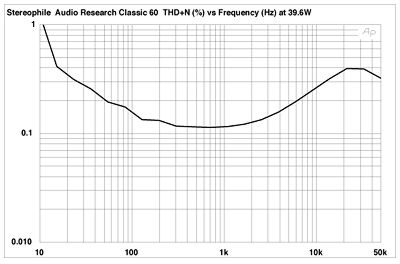
Fig.4 Audio Research Classic 60, 8 ohm tap, THD+noise vs frequency at 39.6W into 8 ohms.
This good performance is confirmed by fig.5, which shows the distortion and spuriae spectrum from 10Hz to 1kHz with an almost full-power 50Hz sinewave being delivered into 8 ohms. The distortion is primarily odd-order—the cursor shows the fifth harmonic at 250Hz, 58.9dB below the fundamental, 0.11%, which is the highest in level. Note also the absence of AC line-related components; the 120Hz full-wave rectified frequency is nearly 90dB down, implying a good, "stiff" power supply for the output tubes; though the 180Hz component can be seen at -82dB, this again is low for a tube amplifier near clipping. Only regarding intermodulation distortion did the Classic 60 do less well than an equivalent, low-feedback solid-state design. Driving a 1:1 mix of 19 and 20kHz sinewaves at the amp's clipping point, driving 8 ohms from the 8 ohm tap—admittedly an extremely severe test—the 1kHz difference tone was apparent at around 0.3%, with many other products emerging around the 0.1% level.

Fig.5 Audio Research Classic 60, 8 ohm tap, spectrum of 50Hz sinewave, DC-1kHz, at 55.7W into 8 ohms (linear frequency scale).
Finally, looking at the manner in which the Classic 60 handles squarewave signals, fig.6 shows a 1kHz squarewave with the 60 driving an 8 ohm load from its 4 ohm output tap, the level being 8.1V RMS. At higher levels than this from this tap into 8 ohms, a leading-edge spike developed without any increase in the height of the wavetops being developed. Into lower impedances, a slight ring developed on the squarewave leading edge, even at low levels, as can be seen in fig.7, which shows a 10kHz squarewave at 1.4V RMS. (No anti-aliasing filter was used when this waveform was captured; the effective sampling rate was 2.5MHz, which should have pushed any alias components below the Heath/Zenith storage 'scope's 8-bit floor.)

Fig.6 Audio Research Classic 60, 4 ohm tap, high-level 1kHz squarewave into 8 ohms.

Fig.7 Audio Research Classic 60, 4 ohm tap, small-signal 10kHz squarewave into 4 ohms.
This slight ring persisted when the Classic 60 was asked to drive real-life loads, fig.8 showing the 10kHz waveform with the amplifier driving a Celestion SL700 loudspeaker. The ringing, however, is well-damped, and has an approximate frequency of 210kHz; ie, a decade above the audio band, where it would be unlikely to have any subjective effect.—John Atkinson

Fig.8 Audio Research Classic 60, 4 ohm tap, small-signal 10kHz squarewave into Celestion SL700.
Footnote 1: I did not carry out any power or distortion measurements from the 16 ohm taps. Not having access to any loudspeakers that would be suitable (possessing a combination of high sensitivity and high impedance) for auditioning from these taps, I regard them as irrelevant in a real-world system.—John Atkinson
- Log in or register to post comments
























